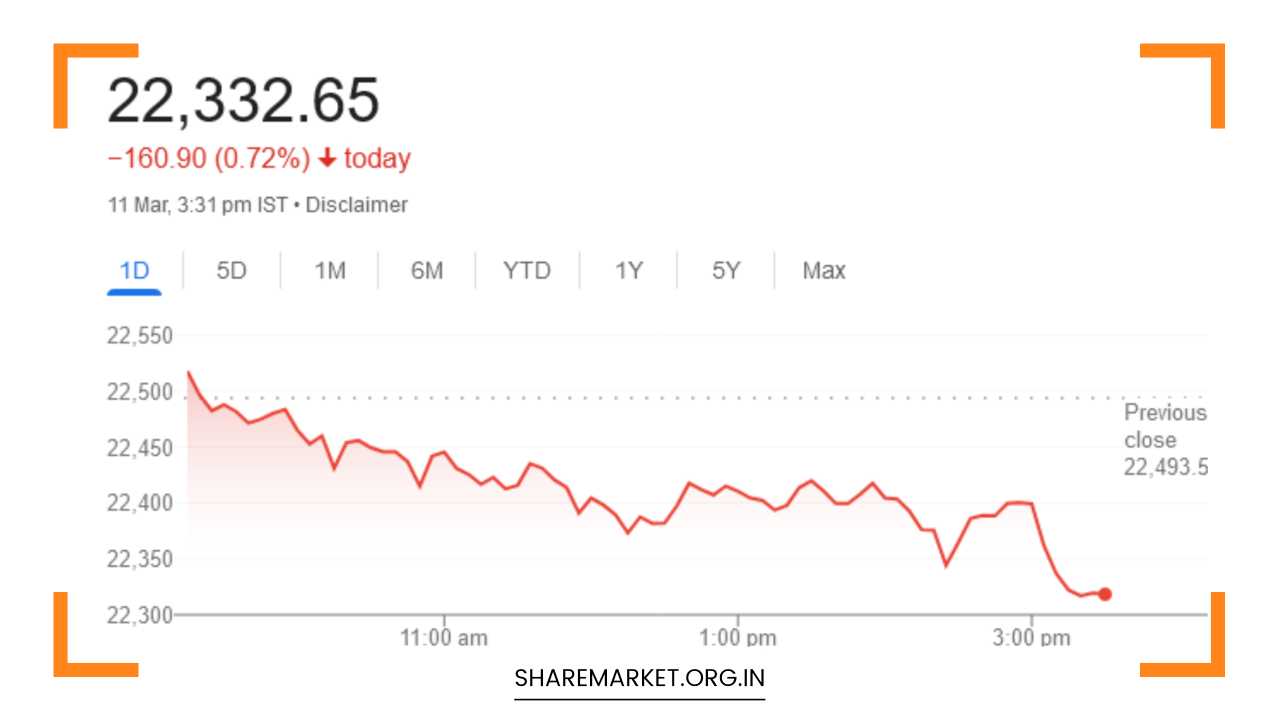Nifty Closed at 22,332; Nifty Prediction for Tomorrow

Nifty Prediction for Tomorrow
Market Analysis and Outlook: Navigating Through Uncertain Waters
The current market landscape presents investors with a complex web of signals and indicators, reflecting a mix of caution and uncertainty.
Daily Bollinger Bands, pointing towards a contraction, suggest an imminent range-bound movement. In the Indian markets, the recent two-day hiatus in gains, coupled with Nifty’s closure below the critical 22,350 mark, has triggered apprehension among investors.
In the backdrop of these concerns, the release of US inflation data loomed large, impacting the market sentiment and resulting in a significant drop in both Sensex and Nifty. The BSE Midcap and Smallcap indices also experienced declines of 0.2% and 2%, respectively, further complicating the market outlook.
Market Performance:
The opening of the market under weak global cues set the tone for a day characterized by fluctuating trends. Despite an initial positive trend driving Nifty to a new all-time high of 22,526.60, the gains proved short-lived, with the market succumbing to downward pressure.
Throughout the trading day, various sectors experienced selling pressure, contributing to a broad-based downturn.
Top performers on Nifty included Apollo Hospitals, Nestle India, Cipla, SBI Life Insurance, and Bajaj Finserv. On the flip side, Tata Consumer Products, Power Grid Corporation, Tata Steel, Bajaj Auto, and SBI emerged as the day’s top losers.
Sectoral indices, spanning Auto, Capital Goods, FMCG, Oil & Gas, Bank, IT, Realty, Metal, and Power, all closed in the red, with declines ranging from 0.5% to 1%.
Expert Analysis and Predictions for March 12:
Jatin Gedia’s Perspective (Sharekhan):
Jatin Gedia from Sharekhan underscores the apparent lack of buying interest in Nifty following a decisive breakout on the daily chart.
The absence of buying momentum, coupled with selling pressure at higher levels, suggests a potential retreat of Nifty into the consolidation zone of 22,100-22,600.
The Daily Bollinger Bands, indicating range contraction, further support the likelihood of extended range-bound actions.
With heavyweight stocks displaying no discernible strength, optimism for a bullish trend is waning. Key support levels for Nifty are identified at 22,224-22,167, while resistance is anticipated at 22,530-22,600.
The analysis extends to Bank Nifty, which, after filling the gap from January 17, faces challenges in sustaining its upward trajectory.
A potential slip towards 46,900-46,800 looms large, introducing an additional layer of uncertainty to the overall market outlook.
Rupak Dey’s Insight (LKP Securities):
Rupak Dey of LKP Securities delves deeper into the technical analysis, shedding light on Nifty’s fluctuation within an ascending channel characterized by higher highs and higher lows.
While the overall trend remains bullish, an intermediate correction is currently underway, suggesting a short-term weakness.
This weakness could manifest as a fall within the range of 22,200-22,250. Immediate resistance, based on recent closing prices, is identified at 22,400.
Comprehensive Analysis and Conclusion:
As investors grapple with conflicting signals and uncertainties, the market landscape demands a nuanced and cautious approach.
The absence of robust buying interest, combined with the potential for further range-bound movements indicated by the Bollinger Bands, underscores the need for vigilance.
Crucial support and resistance levels serve as indispensable markers for investors to monitor, with Bank Nifty’s gap fill and Nifty’s oscillation within an ascending channel contributing to the complexity of the situation.
In this scenario, astute investors may discern opportunities amidst the market fluctuations by strategically leveraging the identified support and resistance zones.
However, a cautious approach is warranted, given the prevailing uncertainties in both domestic and global economic landscapes. Monitoring key indicators and staying abreast of market developments will be essential in navigating the market’s current consolidation phase.
Navigating the Consolidation Phase:
The market’s current consolidation phase demands a strategic approach from investors, recognizing the inherent challenges and opportunities it presents.
The absence of a clear bullish trend requires investors to carefully evaluate their positions and risk tolerance. The Bollinger Bands’ indication of range contraction implies potential limitations on price movements, emphasizing the importance of identifying key support and resistance levels.
For Nifty, the identified support levels at 22,224-22,167 serve as critical anchors, providing a potential cushion against further downside risks.
On the flip side, resistance at 22,530-22,600 represents a significant hurdle that the index must overcome to regain a bullish momentum. These levels serve as crucial decision points for traders, helping them navigate through the market’s ebb and flow.
The analysis extends to Bank Nifty, which, after filling the gap created on January 17, finds itself at a crossroads. The potential slip towards 46,900-46,800 adds an element of caution, prompting investors to reassess their risk exposure.
The intricacies of Bank Nifty’s movements necessitate a granular understanding of support and resistance levels to make informed decisions.
Riding the Waves: Identifying Opportunities Amidst Challenges:
While challenges abound, adept investors can discern opportunities within the market’s undulating movements. The identification of support and resistance zones facilitates strategic entry and exit points, allowing investors to capitalize on price fluctuations.
The day’s top performers, including Apollo Hospitals, Nestle India, Cipla, SBI Life Insurance, and Bajaj Finserv, present potential areas of interest for those seeking opportunities amid the market’s uncertainty.
Conversely, the top losers, such as Tata Consumer Products, Power Grid Corporation, Tata Steel, Bajaj Auto, and SBI, warrant careful scrutiny. Understanding the underlying factors contributing to their decline can inform future investment decisions.
The sectoral indices’ widespread declines, spanning Auto, Capital Goods, FMCG, Oil & Gas, Bank, IT, Realty, Metal, and Power, call for a sector-specific analysis to uncover pockets of resilience or vulnerability.
Final Remarks: Navigating the Turbulence with Prudence:
In conclusion, the current market outlook demands a prudent and informed approach from investors. The intricate interplay of technical indicators, expert analyses, and market dynamics requires a comprehensive understanding to navigate the prevailing turbulence.
While challenges exist, they coexist with opportunities for those who carefully analyze the support and resistance levels, sectoral performances, and broader economic factors.
Investors are urged to stay vigilant, reassess their risk exposure, and remain adaptable in response to emerging market trends.
The market’s consolidation phase is not merely a challenge but an invitation for astute investors to showcase their ability to ride the waves of uncertainty with strategic acumen.

















